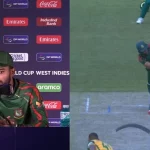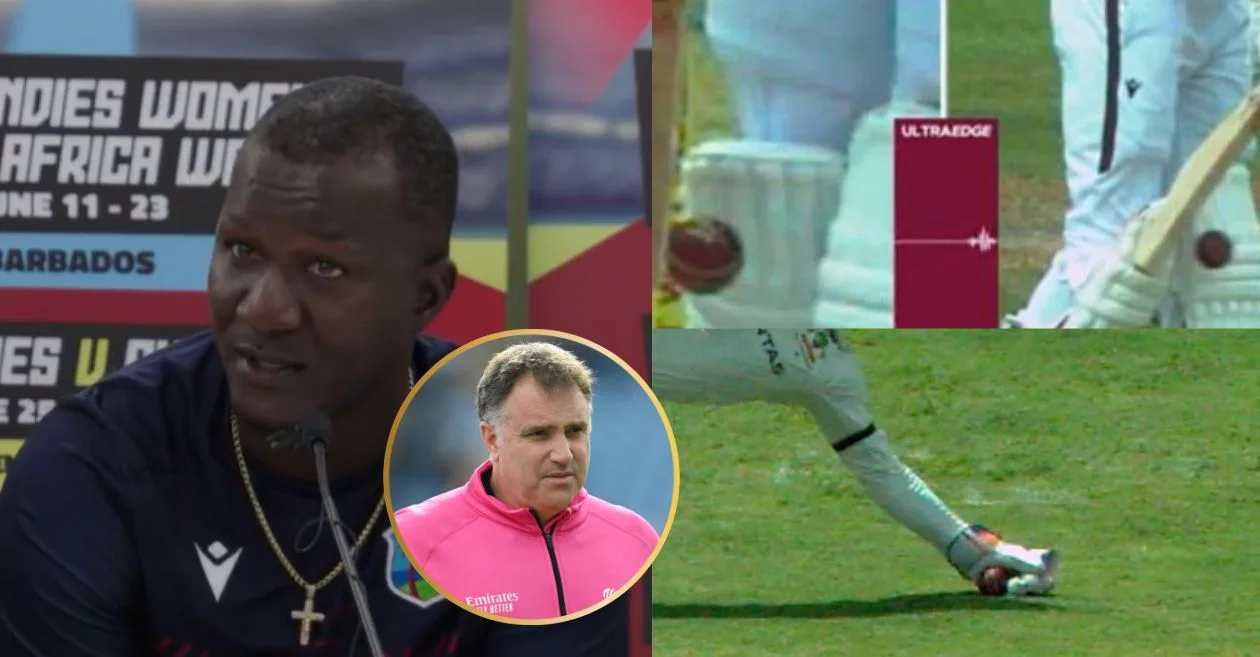In a Test match already brimming with drama, the second day of the first Test between West Indies and Australia at Kensington Oval in Bridgetown took a sharp turn from cricketing battle to controversial chaos, as West Indies head coach Daren Sammy launched a scathing criticism of TV umpire Adrian Holdstock over two highly debated dismissals.
In a rare post-day press interaction that blended calm reasoning with rising emotion, Sammy didn’t mince words. He questioned the integrity of decision-making, highlighted perceived inconsistencies in ultra-edge and replay protocols, and raised concerns about trust and fairness—cornerstones of Test cricket.
At the heart of the storm were two contentious dismissals—Roston Chase’s LBW and Shai Hope’s caught-behind—both ruled in Australia’s favour after TV umpire reviews. And while cricket is no stranger to DRS debates, what set this situation apart was Sammy’s firm, direct, and historical grievance with one official in particular.
Roston Chase’s LBW: The Flashpoint
The most heated moment of Day 2 unfolded when Roston Chase, West Indies’ captain and batting anchor, was adjudged LBW to Pat Cummins in a pivotal moment of the West Indies innings. Chase had been shaping up well alongside Shai Hope in a gritty partnership, when Cummins rapped him on the pad with a sharp in-dipper.
Initially given out on-field, Chase opted for a review. UltraEdge revealed a clear spike as the ball passed the bat—potentially an inside edge—but the third umpire, Adrian Holdstock, determined there was insufficient conclusive evidence to overturn the decision.
This despite visible signs of deviation on ball tracking and a synchronized UltraEdge signal.
Sammy, visibly irate in the post-day presser, questioned the rationale:
“There was a spike, there was deviation, and still it was upheld. What more do you need to overturn a call? We just want consistency.”
He further added:
“This isn’t about one decision. I’ve seen this before. Especially with this particular umpire—it happened in England, and it’s happening again.”
The “particular umpire” in question—Adrian Holdstock—is a seasoned official from South Africa, but his track record in matches involving West Indies, according to Sammy, has been dotted with what he called “irregular interpretations of technology.”
Hope’s Controversial Dismissal: Doubt But No Benefit
If Chase’s dismissal was borderline, Shai Hope’s was worse, as per Sammy. Hope, who was playing in his comeback Test and had looked solid with 48 patient runs, was given caught behind after a sharp appeal off Mitchell Starc.
The replays, however, showed no clear deviation, and the UltraEdge was inconclusive. Still, the decision stood—another major moment going against the West Indies.
This time, the frustration was more muted on the field but louder off it.
“If there is doubt, the batter gets the benefit, right? At least that’s what we’re taught. But it seems not all doubts are created equal,” Sammy said. “Two decisions, both involving Roston and Shai, and both went against us in nearly identical scenarios. You start to ask questions.”
Not Just West Indies: Australia Raise Eyebrows Too
Interestingly, the frustration was not one-sided. Australia’s pacer Mitchell Starc also voiced concerns post-match, albeit with more caution. He referenced an earlier incident on Day 2 where the Aussies felt Roston Chase was out LBW, but the TV umpire upheld the on-field not-out verdict due to lack of conclusive evidence.
Starc remarked:
“We thought we had him plumb earlier in the day. We were surprised it wasn’t overturned. Later, in a similar situation, the decision goes the other way. The Snicko and image sync seemed off to me. I just hope it’s not a tech issue.”
This cross-team consensus—where both sides expressed dissatisfaction with the DRS process—painted a rare picture. And for a high-stakes Test series, where every session counts, such inconsistencies are more than just technical hiccups—they influence momentum, belief, and strategy.
The Bigger Issue: Sammy Demands Procedural Clarity
While Sammy refrained from encouraging his players to challenge the officials publicly, he made it clear that discussions with the match referee, Javagal Srinath, had already taken place.
“I spoke to the match referee. I needed to understand how these decisions are being judged,” Sammy confirmed. “We’re professionals, we understand the game. We just want procedural clarity. We want to trust the system.”
He also hinted that an official complaint or letter to the ICC might be forthcoming:
“You’ll have to wait and see,” he said when asked whether West Indies Cricket would escalate the matter formally.
However, he remained measured in one crucial area:
“I’ve told the players—we don’t go after umpires. We know the rules, we respect the officials. But we also have the right to demand consistency and fairness.”
Media Reaction: “Is DRS Losing Credibility?”
Cricketing circles were quick to pick up the controversy. Analysts on Cricbuzz, ESPNcricinfo, and regional Caribbean networks weighed in, with several commentators questioning the use of DRS in its current form.
Former West Indies bowler Ian Bishop, now a prominent broadcaster, tweeted:
“Disappointed in what we saw today. Technology is supposed to remove doubt, not create more. Clear spike, deviation—how is that not enough?”
Australian pundit Mark Waugh, usually critical of West Indies tactics, was unusually empathetic:
“I’d be furious too if I were Sammy. That was a bad call. If Snicko shows contact and the ball changes direction, that should be enough.”
Twitter hashtags like #HoldstockControversy, #DRSDrama, and #JusticeForChase began trending in cricketing communities.
Match Context: A Test on the Knife’s Edge
Beyond the controversy, the cricket on Day 2 was sublime. The game is tantalizingly poised. After Australia were bowled out for 180, the West Indies rode on Chase and Hope’s partnership to reach 190—a slender but critical 10-run lead.
In their second innings, Australia were 92/4 at stumps, leading by just 82 runs, with Travis Head and Beau Webster at the crease.
This Test has delivered gritty cricket, unpredictable pitch behavior, and intense strategy. But now, it also carries the burden of controversy clouding clarity, potentially shifting how both teams approach the remainder of the match.
Sammy’s Legacy and Leadership on Trial
For Daren Sammy, this moment is pivotal—not just tactically but philosophically. As the first Black head coach of the West Indies men’s team in over a decade and a national icon, his tenure has been defined by bold decisions, honesty, and an open emotional connection with his players.
Taking a public stand against umpiring isn’t new in cricket—but Sammy’s assertiveness, delivered with calculated composure, will likely resonate across global cricket boards.
By speaking up, he’s done more than defend his players—he’s challenged the system to uphold the fairness it promises.
What’s Next: Day 3 Beckons Amid High Tension
With the game hanging in balance, all eyes will now be on Day 3, not just for cricketing skill but for signs of how the players, the umpires, and the broadcasters respond to the tension created.
Will technology protocols be re-examined? Will players show visible frustration? Will there be further drama?
And most importantly—will cricket, the pure contest, reclaim center stage?
When Cricket’s Heart and Head Clash
Test cricket, at its best, is a battle of mind and muscle. But it also rests on one foundational truth: trust in the process. When that is shaken—whether by flawed interpretations, technological missteps, or unacknowledged errors—it invites questions far larger than the match itself.
Daren Sammy didn’t demand perfection. He didn’t ask for favours. He asked for consistency. And in doing so, he reminded the world that while players play the game, it is the system’s responsibility to protect its integrity.
As the Bridgetown Test heads into a potentially historic third day, one thing is certain: the cricketing world will be watching every frame a little more closely.
Match Summary After Day 2:
-
Australia 1st Innings: 180 all out
-
West Indies 1st Innings: 190 all out
-
Australia 2nd Innings: 92/4 (Head 22*, Webster 17*)
-
Australia lead by 82 runs with 6 wickets remaining
Stay tuned for Day 3 coverage, player reactions, and expert analysis as the Test continues amidst drama, doubt, and determination in Bridgetown.
Please check for information on the best betting sites in India – https://selectory.org/best-betting-sites/
Related posts:
 Sunil Narine opens up on his T20 World Cup return after performing exceptionally well in IPL 2024
Sunil Narine opens up on his T20 World Cup return after performing exceptionally well in IPL 2024
 IPL 2024, GT vs CSK: Narendra Modi Stadium Pitch Report, Ahmedabad Weather Forecast, T20 Stats & Records | Gujarat Titans vs Chennai Super Kings
IPL 2024, GT vs CSK: Narendra Modi Stadium Pitch Report, Ahmedabad Weather Forecast, T20 Stats & Records | Gujarat Titans vs Chennai Super Kings
 IPL: Kochi Tuskers Kerala didn’t pay money to cricketers, reveals former India pacer S. Sreesanth
IPL: Kochi Tuskers Kerala didn’t pay money to cricketers, reveals former India pacer S. Sreesanth
 IPL 2024: ‘Facetime me with the trophy’: Jos Buttler’s message before leaving the Rajasthan Royals camp for England duty
IPL 2024: ‘Facetime me with the trophy’: Jos Buttler’s message before leaving the Rajasthan Royals camp for England duty
 IPL 2024: Punjab Kings’ Kagiso Rabada and Liam Livingstone return home due to different reasons
IPL 2024: Punjab Kings’ Kagiso Rabada and Liam Livingstone return home due to different reasons
 In Pics: Meet Erin Holland – Ben Cutting’s wife who is doing anchoring in IPL 2024
In Pics: Meet Erin Holland – Ben Cutting’s wife who is doing anchoring in IPL 2024
 IPL 2024, RCB vs CSK: Mohammad Kaif names the bowler who could stop MS Dhoni in death overs
IPL 2024, RCB vs CSK: Mohammad Kaif names the bowler who could stop MS Dhoni in death overs
 T20 World Cup 2024: Controversial umpiring decision leaves Towhid Hridoy frustrated after Bangladesh’s narrow loss to South Africa
T20 World Cup 2024: Controversial umpiring decision leaves Towhid Hridoy frustrated after Bangladesh’s narrow loss to South Africa
 BAN vs NED, T20 World Cup: Match Prediction, Dream11 Team, Fantasy Tips & Pitch Report | Bangladesh vs Netherlands 2024
BAN vs NED, T20 World Cup: Match Prediction, Dream11 Team, Fantasy Tips & Pitch Report | Bangladesh vs Netherlands 2024
 T20 World Cup 2024: Imam-ul-Haq fires back at Ahmed Shehzad’s ‘Fake King’ comment on Pakistan captain Babar Azam
T20 World Cup 2024: Imam-ul-Haq fires back at Ahmed Shehzad’s ‘Fake King’ comment on Pakistan captain Babar Azam
 T20 World Cup 2024: Stephen Fleming calls for a major change in Team India’s playing XI for the Super 8
T20 World Cup 2024: Stephen Fleming calls for a major change in Team India’s playing XI for the Super 8
 SL vs NZ : Lockie Ferguson’s hat-trick against Sri Lanka in the 2nd T20I
SL vs NZ : Lockie Ferguson’s hat-trick against Sri Lanka in the 2nd T20I
 West Indies announce squad for India tour; Stafanie Taylor out, Deandra Dottin returns to ODIs
West Indies announce squad for India tour; Stafanie Taylor out, Deandra Dottin returns to ODIs
 AUS vs IND: Wasim Jaffer explains why Ravichandran Ashwin should play over Washington Sundar in the Pink Ball Test
AUS vs IND: Wasim Jaffer explains why Ravichandran Ashwin should play over Washington Sundar in the Pink Ball Test
 Mumbai Indians announce new fielding coach ahead of IPL 2025
Mumbai Indians announce new fielding coach ahead of IPL 2025
